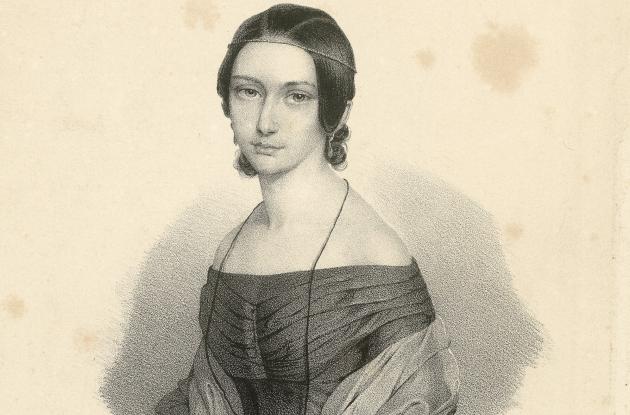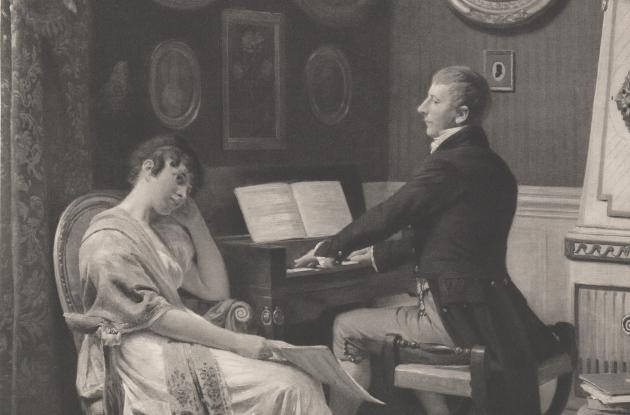The musician
When Weyse sat at the organ in Vor Frue Church in Copenhagen, he could "move to tears" according to the composer Franz Liszt.
Weyse was born in the town of Altona near Hamburg; Altona was then part of the Danish state. As a 15-year-old, he came to Copenhagen in 1789, where he lived for the rest of his life. From 1805, Weyse was organist at Vor Frue Church, the current Copenhagen Cathedral. For the past several years, he lived in Kronprinsessegade with a view of Kongens Have. In his apartment, Weyse had several lodgers, among others his foster son Ferdinand Schauenburg Müller, whom he later helped to get an organ position in Vallø.
Weyse's letters, which Royal Danish Library has in the collections, not surprisingly, gives a good impression of his musical taste. Stylistically, he preserved his life through his interest and fondness for the Viennese classics, as known by Haydn and Mozart. This is clearly expressed in his seven symphonies, which are beautiful and well-composed youth works, and it is also heard in the singing games. In the morning and evening songs, which originate from Weyse's late years, we are talking about an increasingly refined version of the Viennese classic, but Weyse did not generally show any greater openness to the music of the new age. Beethoven's works, which in Weyse's lifetime must have been a hot topic for music enthusiasts, he did not care for.

Photo: Em. Bærentzen
Visits by Clara Schumann and Franz Liszt
In 1842 Clara Schumann visited Copenhagen. She already had a big name as a pianist. During her stay, she visited Weyse. In a letter from February 23 to foster son Ferdinand Schauenburg Müller, Weyse writes:
"She is not beautiful, but has a pleasant, very suffering expression on her face. [-] Mrs. Schumann played for me ein Lied ohne Worte, with a nice touch, and a good posture in the hands, as well as with expression, - however with the [sic] modern affected lecture, a constant wave up and down of rallentando and accelerando , accompanied by a ditto Body movement.”
Franz Liszt, like Clara Schumann, had paid Weyse a visit, and the host had tried to "test" the two guests with his own piano note in F minor. But the test did not turn out in favor of the guests:
“She asked me not to play, but I played anyway, and tried her musical Sense with my F minor Etude. But this test, like with Liszt, had a bad outcome. The etude bothered her very little, and she regaled me with a cold: sehr hübsch! – and I knew what I wanted to know. [-] She didn't like my clave either, and has expressed her astonishment at Ohlsen that I played on such a - chopping board. Fool.”
CLARA SCHUMANN
Clara Schumann (1819-1896) made her first public appearances as a pianist in 1828. During her long career, she contributed greatly to the piano works of her husband Robert Schumann and Johannes Brahms. From her very young years she had been a diligent composer, but already at the age of twenty she largely lost faith that she, as a woman, could have her works respected. Nowadays, Clara Schumann is considered an important German Romantic composer.

Photo: Henri Lehmann
The organ's "Glory of Greatness"
Although Liszt and Clara Schumann did not pass Weyse's test, the former was actually enthusiastic about Weyse's organ playing. In July 1841, Liszt visited Copenhagen, where during the visit he attended a concert with Weyse at the organ of Vor Frue Church under private circumstances. Liszt described his impressions in a letter, and this description was printed in Danish in the newspaper Fædrelandet. Although the text has been translated, it has retained a freshness that makes it a breathtaking description. Liszt tells:
"I stood immersed in these considerations when the Church suddenly resounded with a long and mighty tone. It was the organ that, at the behest of its master, raised its high, earnest voice, as if to reproach me for my doubt, my reluctance. Silent and humble I listened to this Voice. The one who brought the silent walls to life was Weyse, in whom one finds the deep enthusiasm and high courage of Sebastian Bach. More than once I was about to hear him moved to tears; his improvised Fugue on two themes in five tempos, which without exaggeration lasted about half an hour, left me in awe. Never had the organ thus revealed itself to me in the splendor and fullness of its grandeur. But I hadn't yet heard Mendelssohn either.”
Liszt refers here to the composer Felix Mendelssohn Bartholdy.
It is striking that the two visits by two of the great musical personalities of the day did not make a big impression on Weyse. Equally – and actually more interesting – is that Weyse's organ made such an indelible impression on Liszt.
FRANZ LISZT
Franz Liszt (1811-1886) was the most famous pianist of his time. There was talk of his formidable piano technique, which he used to enchant large crowds of admiring audiences. But behind this facade hid a significant composer of orchestral works such as Eine Faustliszt-Symphonie and numerous religious choral works. Liszt also composed organ works, including some of the most significant of Romanticism.
